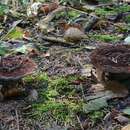pt-BR
nomes no trilho de navegação


Phaeolus is a genus of polypore fungi in the family Fomitopsidaceae. The generic name is derived from the Ancient Greek word φαιος meaning "dark" or "obscure".[2]
Phaeolus is a genus of polypore fungi in the family Fomitopsidaceae. The generic name is derived from the Ancient Greek word φαιος meaning "dark" or "obscure".
I funghi appartenenti al genere Phaeolus (Pat.) Pat. (1900) sono lignicoli, generalmente bruni, con corpo fruttifero da pileato a sessile, spesso imbutiforme, con spore giallastre, lisce.
La specie tipo è Phaeolus schweinitzii (Fr.) Pat. (1900).
I funghi appartenenti al genere Phaeolus (Pat.) Pat. (1900) sono lignicoli, generalmente bruni, con corpo fruttifero da pileato a sessile, spesso imbutiforme, con spore giallastre, lisce.
Phaeolus (Pat.) Pat. (murszak) – rodzaj grzybów z rodziny pniarkowatych (Fomitopsidaceae)[1].
Pozycja w klasyfikacji według Index Fungorum: Fomitopsidaceae, Polyporales, Incertae sedis, Agaricomycetes, Agaricomycotina, Basidiomycota, Fungi[1].
Synonimy: Choriphyllum Velen., Polyporus subgen. Phaeolus Pat., Romellia Murrill, Spongiosus Lloyd ex Torrend[2].
Polską nazwę nadał Henryk Orłoś w 1966 r. W polskim piśmiennictwie mykologicznym rodzaj ten opisywany były także jako huba lub żagiew[3].
Nazwy naukowe na podstawie Index Fungorum[4]. Nazwy polskie według Władysława Wojewody[3].
Phaeolus (Pat.) Pat. (murszak) – rodzaj grzybów z rodziny pniarkowatych (Fomitopsidaceae).